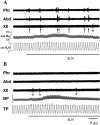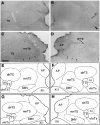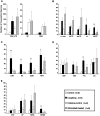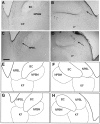Differential brainstem Fos-like immunoreactivity after laryngeal-induced coughing and its reduction by codeine
- PMID: 9364079
- PMCID: PMC6573604
- DOI: 10.1523/JNEUROSCI.17-23-09340.1997
Differential brainstem Fos-like immunoreactivity after laryngeal-induced coughing and its reduction by codeine
Abstract
We used the expression of the immediate-early gene c-fos, a marker of neuronal activation, to localize brainstem neuronal populations functionally related to fictive cough (FC). In decerebrate, paralyzed, and ventilated cats, the level of Fos-like immunoreactivity (FLI) was examined in five groups of animals: (1) controls, sham-operated unstimulated animals; (2) coughing cats, including both animals in which FC was elicited by unilateral electrical stimulation of the superior laryngeal nerve (SLN) and (3) those in which FC was elicited by bilateral SLN stimulation; (4) stimulated-treated cats, in which bilateral SLN stimulation was applied after selective blockade of FC by codeine; and (5) codeine controls, sham-operated unstimulated cats subjected to administration of codeine. Fifteen brainstem structures were compared for numbers of labeled cells. Because codeine selectively blocks FC, brainstem nuclei activated specifically during FC were identified as regions showing increased FLI after FC and significant reductions in FLI after FC suppression by codeine in stimulated-treated cats. In coughing animals, we observed a selective immunoreactivity in the interstitial and ventrolateral subdivisions of the nucleus of the tractus solitarius, the medial part of the lateral tegmental field, the internal division of the lateral reticular nucleus, the nucleus retroambiguus, the para-ambigual region, the retrofacial nucleus, and the medial parabrachial nucleus. FLI in all these nuclei was significantly reduced in stimulated-treated cats. Our results are consistent with the involvement of neurons overlapping the main brainstem respiratory-related regions as well as the lateral tegmental field and the lateral reticular nucleus in the neural processing of laryngeal-induced FC.
Figures









Similar articles
-
Brainstem circuitry of tracheal-bronchial cough: c-fos study in anesthetized cats.Respir Physiol Neurobiol. 2008 Feb 29;160(3):289-300. doi: 10.1016/j.resp.2007.10.014. Epub 2007 Oct 30. Respir Physiol Neurobiol. 2008. PMID: 18055277 Free PMC article.
-
Brainstem areas involved in the aspiration reflex: c-Fos study in anesthetized cats.Physiol Res. 2004;53(6):703-17. Physiol Res. 2004. PMID: 15588140
-
Emetic reflex arc revealed by expression of the immediate-early gene c-fos in the cat.J Neurosci. 1994 Feb;14(2):871-88. doi: 10.1523/JNEUROSCI.14-02-00871.1994. J Neurosci. 1994. PMID: 8301366 Free PMC article.
-
Functional and morphological organization of the nucleus tractus solitarius in the fictive cough reflex of guinea pigs.Neurosci Res. 2005 Oct;53(2):201-9. doi: 10.1016/j.neures.2005.06.016. Neurosci Res. 2005. PMID: 16040147
-
Central mechanisms II: pharmacology of brainstem pathways.Handb Exp Pharmacol. 2009;(187):203-17. doi: 10.1007/978-3-540-79842-2_10. Handb Exp Pharmacol. 2009. PMID: 18825342 Free PMC article. Review.
Cited by
-
Cough modulation by upper airway stimuli in cat - potential clinical application?Open J Mol Integr Physiol. 2016 Aug;6(3):35-43. doi: 10.4236/ojmip.2016.63004. Epub 2016 Aug 22. Open J Mol Integr Physiol. 2016. PMID: 28944100 Free PMC article.
-
Correspondence between laryngeal vocal fold movement and muscle activity during speech and nonspeech gestures.J Appl Physiol (1985). 2004 Sep;97(3):858-66. doi: 10.1152/japplphysiol.00087.2004. Epub 2004 May 7. J Appl Physiol (1985). 2004. PMID: 15133000 Free PMC article. Clinical Trial.
-
Effects of aging and levodopa on the laryngeal adductor reflex in rats.Exp Gerontol. 2012 Dec;47(12):900-7. doi: 10.1016/j.exger.2012.07.008. Epub 2012 Jul 21. Exp Gerontol. 2012. PMID: 22824541 Free PMC article.
-
Central nervous system control of the laryngeal muscles in humans.Respir Physiol Neurobiol. 2005 Jul 28;147(2-3):205-22. doi: 10.1016/j.resp.2005.04.015. Respir Physiol Neurobiol. 2005. PMID: 15927543 Free PMC article. Review.
-
Peripheral and central mechanisms of cough hypersensitivity.J Thorac Dis. 2020 Sep;12(9):5179-5193. doi: 10.21037/jtd-2020-icc-007. J Thorac Dis. 2020. PMID: 33145095 Free PMC article. Review.
References
-
- Abbadie C, Besson J-M. Effects of morphine and naloxone on basal and evoked Fos-like immunoreactivity in lumbar spinal cord neurons of arthritic rats. Pain. 1993;52:29–39. - PubMed
-
- Bellingham MC, Lipski J. Morphology and electrophysiology of superior laryngeal nerve afferents and post-synaptic neurons in the medulla oblongata of the cat. Neuroscience. 1992;48:205–216. - PubMed
-
- Bereiter DA, Hathaway CB, Benetti AP. Caudal portions of the spinal trigeminal complex are necessary for autonomic responses and display Fos-like immunoreactivity after corneal stimulation in the cat. Brain Res. 1994;657:73–82. - PubMed
-
- Berman AL. The brainstem of the cat: a cytoarchitectonic atlas with stereotaxic coordinates. Milwaukee: University of Wisconsin; 1968.
-
- Bianchi AL, Denavit-Saubié M, Champagnat J. Central control of breathing in mammals: neuronal circuitry, membrane properties, and neurotransmitters. Physiol Rev. 1995;75:1–46. - PubMed
Publication types
MeSH terms
Substances
LinkOut - more resources
Full Text Sources
Other Literature Sources
Medical
Miscellaneous
